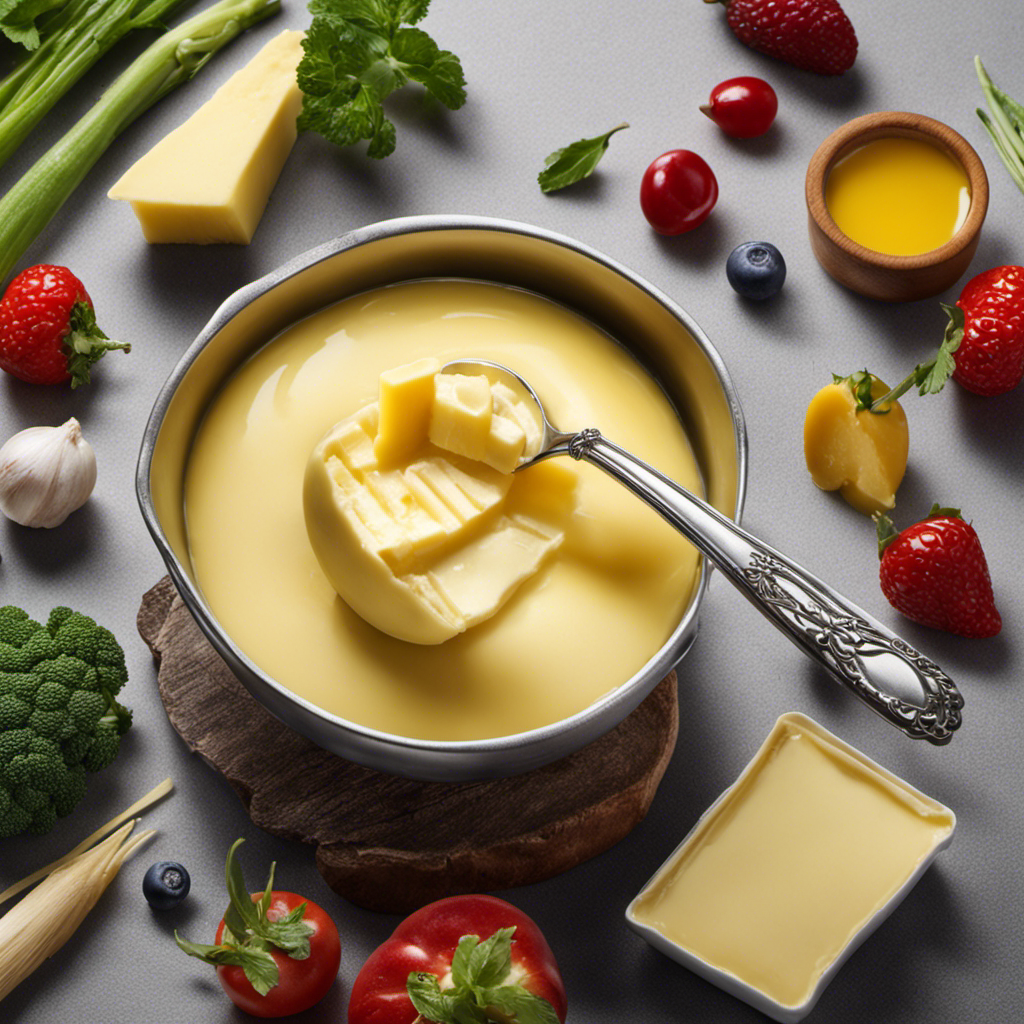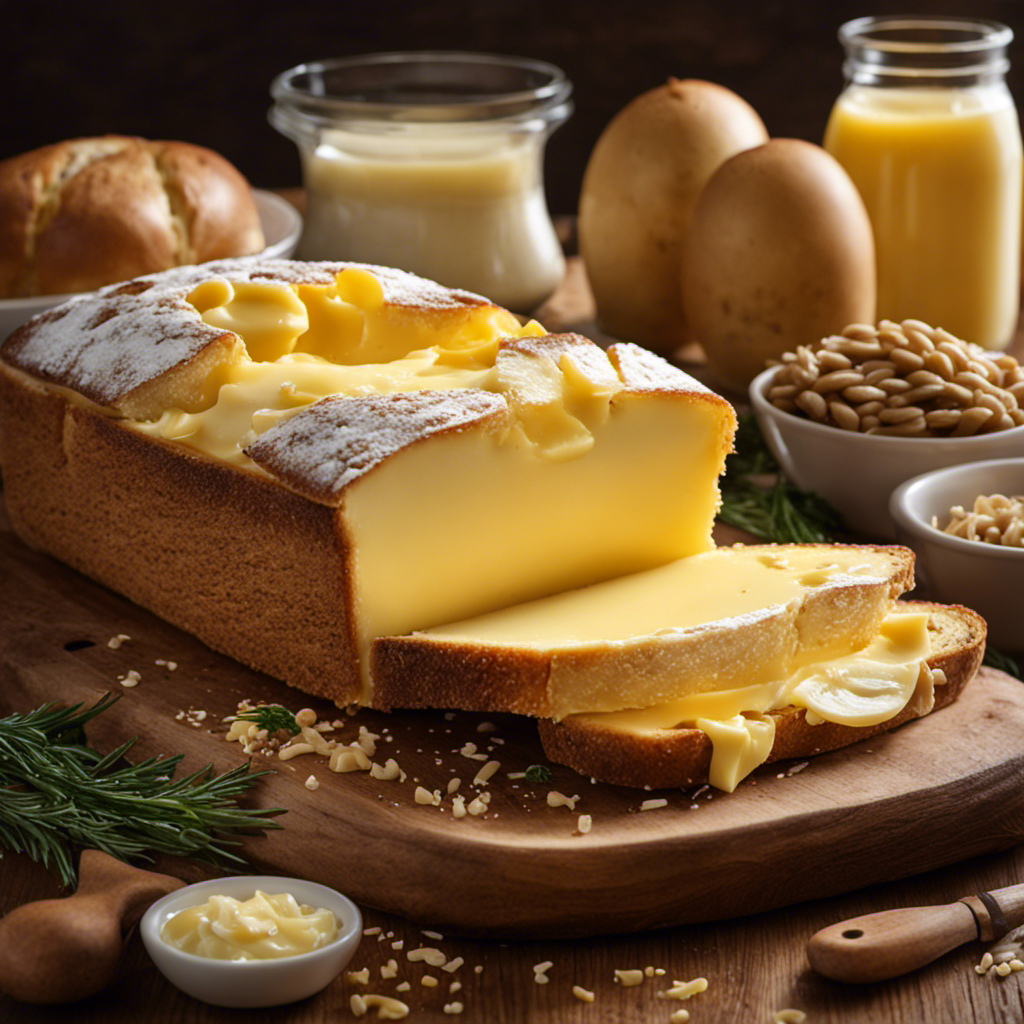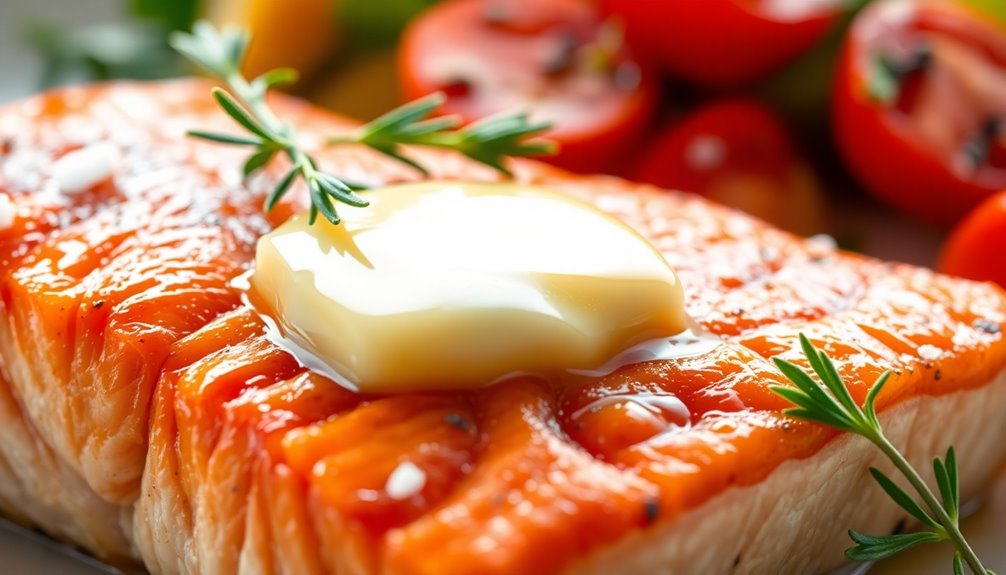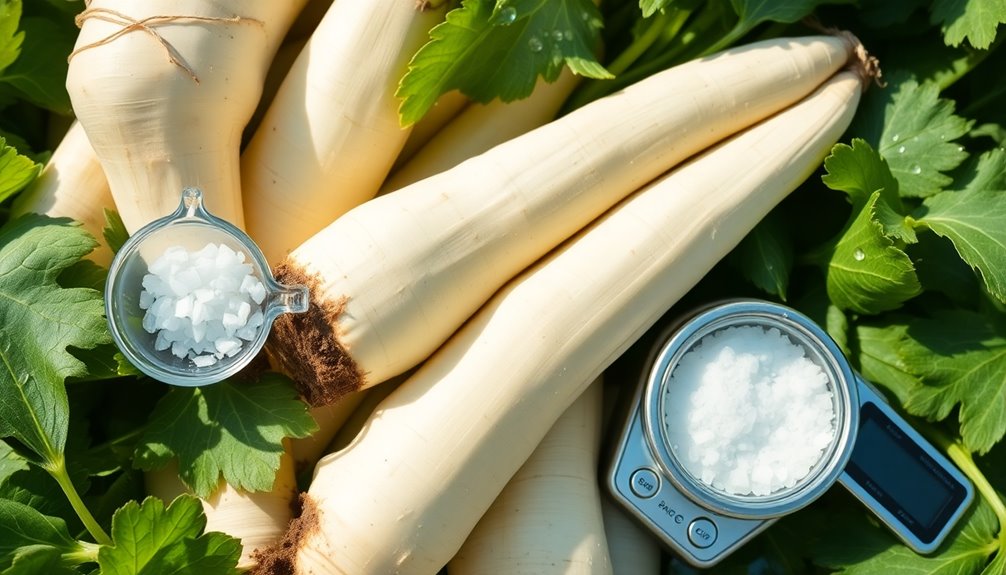I have constantly wondered about the caloric value of butter. It is a versatile ingredient that enhances the richness and flavor of numerous dishes.
But how many calories are we really consuming when we use a tablespoon of butter? In this article, we’ll dive into the numbers and uncover the truth about the calorie count in butter.
Understanding this information is crucial for anyone looking to manage their weight or make informed dietary choices. So, let’s get started and shed some light on this buttery topic.
Key Takeaways
- A tablespoon of butter contains approximately 100 calories.
- Butter is high in saturated fats, which can contribute to weight gain and increase the risk of heart disease.
- Butter alternatives provide lower calorie and fat options, made from healthier oils like olive or coconut oil.
- Substituting butter with healthier alternatives can reduce calorie intake while still adding flavor.
The Caloric Content of a Tablespoon of Butter
There’s approximately 100 calories in a tablespoon of butter.
Understanding butter’s composition and nutritional value can help us make informed choices about our diet. Butter is primarily composed of fat, with small amounts of protein and water.
The fat in butter is mostly saturated fat, which is known to raise cholesterol levels and increase the risk of heart disease. However, butter also contains important vitamins like vitamin A, D, E, and K, as well as trace amounts of minerals like calcium and phosphorus.
While butter can add flavor to dishes, it is important to consume it in moderation due to its high caloric content and saturated fat content.
Understanding the Calorie Count in Butter
When it comes to understanding the calorie count in butter, it is important to be aware of the portion size and the health implications it can have.
A tablespoon of butter contains approximately 100 calories, so it is crucial to be mindful of how much butter we are consuming in our daily diet.
Consuming excessive amounts of butter can contribute to weight gain and increase the risk of heart disease, so it is essential to practice portion control and choose healthier alternatives when possible.
Butter Calorie Content
The calorie content of a tablespoon of butter is approximately 102 calories. Butter is a rich source of fat and calories, which can contribute to weight gain if consumed in excess. However, it is important to note that not all fats are created equal. Butter contains saturated fats, which have been associated with an increased risk of heart disease when consumed in large amounts.
Despite its high calorie content, butter also provides several essential nutrients, including vitamin A and vitamin D. When incorporating butter into a balanced diet, it is important to consider portion sizes and moderation.
Here are some key points to keep in mind regarding butter nutrition and its potential impact on weight gain:
- Butter is high in calories and fat.
- Consuming large amounts of butter may contribute to weight gain.
- Butter contains saturated fats, which can increase the risk of heart disease.
- Butter is a good source of vitamin A and vitamin D.
- Moderation and portion control are key when including butter in your diet.
Portion Size Awareness
One important factor to consider when incorporating butter into your diet is being aware of portion sizes. Portion control plays a crucial role in managing your calorie intake and maintaining a healthy weight. Measuring butter consumption can help you keep track of the amount you are consuming and ensure that you are not exceeding your daily calorie goals.
A standard tablespoon of butter contains about 102 calories and 11.5 grams of fat. By accurately measuring your butter portions, you can make informed decisions about how much to include in your meals. Remember, moderation is key. You can still enjoy the rich flavor of butter while keeping your calorie intake in check by being mindful of portion sizes and incorporating it into a balanced diet.
Health Implications of Butter
To maintain a healthy weight, it’s important for you to be aware of the health implications of including butter in your diet. While butter is delicious and adds flavor to many dishes, it is high in saturated fats and calories.
Here are some key points to consider:
- Butter is a concentrated source of calories, with each tablespoon containing approximately 100 calories.
- It is also high in saturated fats, which have been linked to an increased risk of heart disease.
- Consuming too much butter can contribute to weight gain and obesity.
- However, butter does have some health benefits, such as being a good source of vitamins A, D, E, and K.
- Moderation is key when it comes to butter consumption, and it’s important to balance it with other nutritious foods.
Understanding the health implications of butter can help you make informed decisions about incorporating it into your diet.
Now, let’s explore the topic of counting calories and how much energy butter provides.
Counting Calories: How Much Energy Does Butter Provide
When it comes to counting calories, understanding the calorie content of butter is essential. A tablespoon of butter typically contains about 102 calories, making it a high-calorie ingredient.
This can have an impact on weight management, as consuming excessive calories from butter can contribute to weight gain. However, there are also butter alternatives available that can provide a lower calorie option for those looking to reduce their calorie intake.
Butter Calorie Content
Did you know that a tablespoon of butter contains approximately 102 calories? Butter is a common ingredient in many recipes and a staple in many households, but it’s important to be aware of its calorie content.
Here are some key points about the butter calorie count and the nutritional value of butter:
- Butter is high in saturated fat, which can increase the risk of heart disease.
- It also contains small amounts of vitamins A, D, E, and K.
- Butter is a good source of conjugated linoleic acid (CLA), which has been linked to potential health benefits.
- It can add flavor and richness to dishes, but it’s important to use it in moderation.
- Substituting butter with healthier alternatives like olive oil or avocado can reduce calorie intake while still adding flavor.
Understanding the calorie content and nutritional value of butter is important for making informed dietary choices.
Now let’s explore how butter consumption can impact weight.
Impact on Weight
If you eat butter in excess, it can contribute to weight gain. Butter is high in calories and fat, so consuming too much of it can lead to an imbalance in energy intake and expenditure, resulting in weight gain over time.
However, it’s important to note that moderate consumption of butter as part of a balanced diet is generally not a cause for concern. The key to managing weight while enjoying butter is portion control.
A tablespoon of butter contains approximately 102 calories and 11 grams of fat. By being mindful of portion sizes and incorporating regular physical activity into your routine, you can still enjoy the taste of butter without compromising your weight management goals.
Butter Alternatives
To reduce your intake of calories and fat, you can try using butter alternatives in your cooking and baking. Butter alternatives provide a healthier option without sacrificing taste. Here are some benefits of using butter alternatives:
-
Lower in calories and fat: Butter alternatives are often made with healthier oils, such as olive or coconut oil, which contain fewer calories and less saturated fat than butter.
-
Plant-based options: Many butter alternatives are made from plant-based ingredients, making them suitable for vegans and those with dairy allergies or lactose intolerance.
-
Heart-healthy fats: Some butter alternatives contain monounsaturated or polyunsaturated fats, which can help reduce bad cholesterol levels and promote heart health.
-
Nutrient-rich: Certain butter alternatives, like almond or cashew butter, provide additional nutrients such as vitamin E, magnesium, and healthy fats.
-
Versatility: Butter alternatives can be used in a variety of ways, from spreading on toast to baking and cooking.
Butter and Caloric Intake: What You Need to Know
When you’re watching your caloric intake, it’s important to know that a tablespoon of butter contains around 100 calories. This is crucial information for anyone who wants to be mindful of their portion sizes and make informed choices about their diet.
Being aware of the caloric content of butter can help you manage your daily calorie intake and maintain a healthy weight. Consuming excessive amounts of butter can have health implications, as it is high in saturated fat and cholesterol. These can contribute to an increased risk of heart disease and other health problems.
The Calorie Breakdown of a Tablespoon of Butter
Knowing the caloric breakdown of a tablespoon of butter can help you make informed choices about your diet. Butter, although delicious, is high in calories and should be consumed in moderation.
Here is the caloric value and nutritional content of a tablespoon of butter:
- Calories: 102
- Total Fat: 11.5 grams
- Saturated Fat: 7.3 grams
- Cholesterol: 30 milligrams
- Sodium: 82 milligrams
These numbers may seem alarming, but it’s important to remember that fat is an essential nutrient that our bodies need. However, consuming too much saturated fat can increase the risk of heart disease.
Butter and Weight Management: Calculating Caloric Value
Now that we know the calorie breakdown of a tablespoon of butter, let’s discuss how it relates to weight management and the importance of portion control.
When it comes to maintaining a healthy weight, understanding the nutritional value of the foods we consume is crucial. Butter is high in calories and saturated fat, so it’s important to be mindful of our portion sizes.
One tablespoon of butter contains around 100 calories, which can add up quickly if not properly accounted for. Incorporating butter into our diet in moderation is key, as part of a balanced meal plan that includes a variety of nutrient-rich foods.
Frequently Asked Questions
Can I Substitute Butter With Margarine to Reduce Calorie Intake?
Yes, you can substitute butter with margarine to reduce calorie intake. Margarine generally has fewer calories than butter, making it a healthier option for those looking to lower their calorie intake.
Is There a Difference in Calorie Content Between Salted and Unsalted Butter?
There is a difference in taste between salted and unsalted butter. Additionally, when comparing nutritional values, the calorie content of a tablespoon of butter remains the same regardless of whether it is salted or unsalted.
How Does the Caloric Content of a Tablespoon of Butter Compare to Other Cooking Oils?
Comparing the caloric content of a tablespoon of butter to other cooking oils, it’s important to consider the nutritional value. While butter has around 100 calories, some oils like olive oil have a similar calorie count but offer more health benefits.
Does the Calorie Count of Butter Change When It Is Melted?
When butter melts, does it retain the same calorie count? How does the caloric content of melted butter compare to solid butter? Let’s explore if the calories change in this delightful transformation.
Are There Any Health Benefits Associated With Consuming Butter in Moderation?
In moderation, butter can provide some nutritional value, such as vitamins A and E. However, it is important to be mindful of the health risks associated with consuming too much saturated fat and cholesterol.
Conclusion
In conclusion, knowing the caloric content of a tablespoon of butter is crucial for those watching their weight. It’s like unlocking a secret code to understanding how much energy you’re adding to your meals.
By being aware of the calorie count, you can make informed choices and manage your caloric intake effectively. Remember, knowledge is power, and in the battle of the bulge, every little bit counts.
So go ahead, arm yourself with the facts and conquer those calories!










